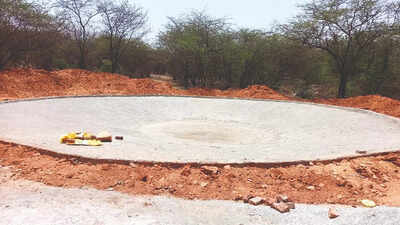- News
- City News
- gurgaon News
- 3 waterbodies come up in Faridabad Aravalis, to recharge groundwater; 4 more soon
3 waterbodies come up in Faridabad Aravalis, to recharge groundwater; 4 more soon

The waterbodies have been developed for rainwater harvesting during monsoon
GURUGRAM: The forest department has developed three waterbodies in the Faridabad Aravalis to improve the habitat for plants and wildlife and the groundwater levels. It is now creating four more ponds in the Aravalis, which will be ready before the monsoon this year. Each of the water bodies spreads across one acre of land.
The water bodies, filled using water tankers at this point, have been developed to catch rainwater during the monsoon. In the Aravalis, several natural lakes have dried up over the years due to mining and excess groundwater extraction. “We have already developed water bodies in Pali, Dhouj and Mohbtabad areas of the Aravalis in the Faridabad district. We are also developing four others, which will be ready before the monsoon,” said Raj Kumar, district forest officer, Faridabad.
He also said that these water bodies are developed strategically in the Aravalis such that water from the higher hills could collect in them naturally. “We are not going to fill these water bodies with tankers always. The water holding capacity of these water bodies will also increase slowly,” he added.
Officials said that prime locations such as Rojka Gujjar near Bandhwari on the Gurugram-Faridabad Road and the Mandawar forest areas where several animals are spotted are also part of the project.
Environmentalists have welcomed the move. Sunil Harsana, who has been working to protect the Aravalis, said, “The Aravali hills are an important protective barrier between the harsh Thar Desert and the populated Gangetic plains. The Aravalis also provide critical hydrological services and climatic modulation, particularly due to forest cover. The creation of water bodies in the Aravalis will improve the forest cover and slow down the process of soil erosion.”
Environmentalists said that the water bodies would also help sustain the animals in the Aravali wildlife corridor and prevent man-animal conflict. “It is a crucial step to increase water bodies in Aravalis. Otherwise, wild animals venture into human territory for water during summer,” said Vaishali Rana Chandra, an environmental activist.
The water bodies, filled using water tankers at this point, have been developed to catch rainwater during the monsoon. In the Aravalis, several natural lakes have dried up over the years due to mining and excess groundwater extraction. “We have already developed water bodies in Pali, Dhouj and Mohbtabad areas of the Aravalis in the Faridabad district. We are also developing four others, which will be ready before the monsoon,” said Raj Kumar, district forest officer, Faridabad.
He also said that these water bodies are developed strategically in the Aravalis such that water from the higher hills could collect in them naturally. “We are not going to fill these water bodies with tankers always. The water holding capacity of these water bodies will also increase slowly,” he added.
Officials said that prime locations such as Rojka Gujjar near Bandhwari on the Gurugram-Faridabad Road and the Mandawar forest areas where several animals are spotted are also part of the project.
Environmentalists have welcomed the move. Sunil Harsana, who has been working to protect the Aravalis, said, “The Aravali hills are an important protective barrier between the harsh Thar Desert and the populated Gangetic plains. The Aravalis also provide critical hydrological services and climatic modulation, particularly due to forest cover. The creation of water bodies in the Aravalis will improve the forest cover and slow down the process of soil erosion.”
Environmentalists said that the water bodies would also help sustain the animals in the Aravali wildlife corridor and prevent man-animal conflict. “It is a crucial step to increase water bodies in Aravalis. Otherwise, wild animals venture into human territory for water during summer,” said Vaishali Rana Chandra, an environmental activist.
FOLLOW US ON SOCIAL MEDIA
FacebookTwitterInstagram
Looking for Something?

Start a Conversation
end of article
Visual Stories
Quick Links
Delhi Air PollutionDelhi TemperatureChennai WeatherBangalore TemperatureCovid vaccination centres in DelhiCoronavirus in DelhiRTPCR test in GurgaonHyderabad RainPollution level in BangaloreDelhi SmogDelhi TemperatureNoida AQIGurgaon AQI todayFire in MumbaiMumbai RainsCovid 19 RT PCR Test in NoidaDelhi AQI todaySrinagar encounter

